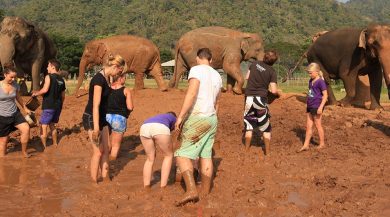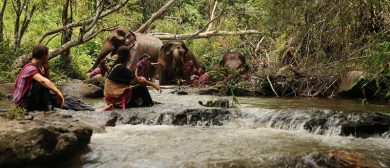
The importance of Chiang Mai’s Elephant Nature Park
While attending the International School Bangkok (ISB), I had the opportunity to participate in Global Citizenship Week. As the name suggests, this is a week dedicated to the expansion of students’ perspectives through travel and community building so that they may become global citizens. The trips stretch as far as Bhutan and Tanzania, but in this article I want to focus on a place that is much closer to home: Chiang Mai’s Elephant Nature Park (ENP).
ENP is a sanctuary dedicated primarily to the care of elephants rescued from the tourist industry, but it also houses hundreds of cats and dogs that were abandoned by their owners in the Thai floods a few years ago, along with other animals. Those of us lucky enough to visit the sanctuary had the chance to meet its founder, Sangduen Chailert (Lek), who clearly has a deep connection with the elephants that have found refuge there.

Since its humble beginnings in the 1990s, ENP has become globally known. Tourists come from far to volunteer with the elephants; this worldwide reputation is a positive thing, because it allows people to learn about the issues of Thailand’s elephant tourism industry. Contrary to what many people believe, the elephant tourism industry engages in dark and troubling practices. It isn’t surprising that tourists are drawn to the elephant tourism industry. Trained elephants in Thailand provide rides through lush forests, watercolours painted with their trunks, back massages done with their large feet, and other endearing performances and activities. What most tourists don’t know is that the training these elephants undergo is abusive and inhumane.
One horror that occurs out of sight is forced breeding: a female elephant is chained up at the disposal of male elephants until she is impregnated. This process goes on for months. In some cases, the mother elephant is so traumatised by her experience that she kills her newborn baby to spare its suffering. Another horror happens to babies that aren’t killed; they are taken from their mothers and subjected to violence. In a process called the Phajaan or “crush,” a young elephant is kept in a tight cage and abused until its spirit is broken. This event is so traumatic that, afterwards, the baby often no longer recognises its mother. During this time, and for the rest of the elephants’ lives, mahouts (elephant riders) target the sensitive skin behind the creatures’ ears, on their necks, and around their eyes with sharp hooks and slingshots.
Sometimes, they are blinded by these slingshots, and if you look closely at an elephant in the Thai tourist industry, you will most likely see scars in these places where cuts have healed again and again. These elephants endure horrors throughout their lives, whether they are enslaved as loggers (pulling heavy logs through forests and up mountains), beggars (begging tourists for money in cities, where they are deprived of food and terrified of the constant noise and activity), or just as performers for tourists to enjoy and engage with. Of course, most people are unaware of what they are supporting when they enjoy these activities.

This is why ENP is so important. At the Elephant Nature Park, I learned that elephants are extremely intelligent and social animals. Baby elephants are not only attached to their mothers, but to their grandmothers and “nannies,” who the mothers assign to take care of their babies should anything happen to them. I saw firsthand the way the older elephants of the herd protected the young. When a baby elephant cried out, the elders rushed to its aid and surrounded it to keep it safe. I learned that elephants aren’t designed to carry weight on their backs, and yet one of the main attractions of the elephant tourist industry is elephant riding; they must carry several people at once for long periods of time, which can take a serious toll on their bodies.
They are often worked until they collapse. Elephants can live to be 70 years old, and their lifecycle is remarkably similar to that of a human’s. Their large ears allow for excellent hearing, their sense of smell is thought to be superior to that of any land animal, and their trunks are extremely versatile. These are just some of the facts I learned about these large and fascinating animals. ENP protects these elephants not only from the tourist industry, but also from extinction. As its website states, there were over 100,000 elephants in Thailand at the turn of the century. Today, because of the killing these creatures have endured at the hands of humans, as well as the loss of habitat they have undergone due to humans’ population growth, only around 3,000 remain.
Chiang Mai’s Elephant Nature Park is an incredible place. Nestled among rolling hills, the park offers stunning views of elephants silhouetted against a gorgeous sky. A river winds beside it, cool and shimmering, which allows a place for volunteers to float on inner tubes. Volunteers and workers walk among the free elephants, helping to clean their stables, bathe them in the river, and cut down food for them to eat. The atmosphere is one of peace, hope, and comfort – for these are the things that ENP has given to all the animals that find refuge there. To learn more about elephants, Lek, and ENP, and to find out how you can help, visit: www.elephantnaturepark.org



